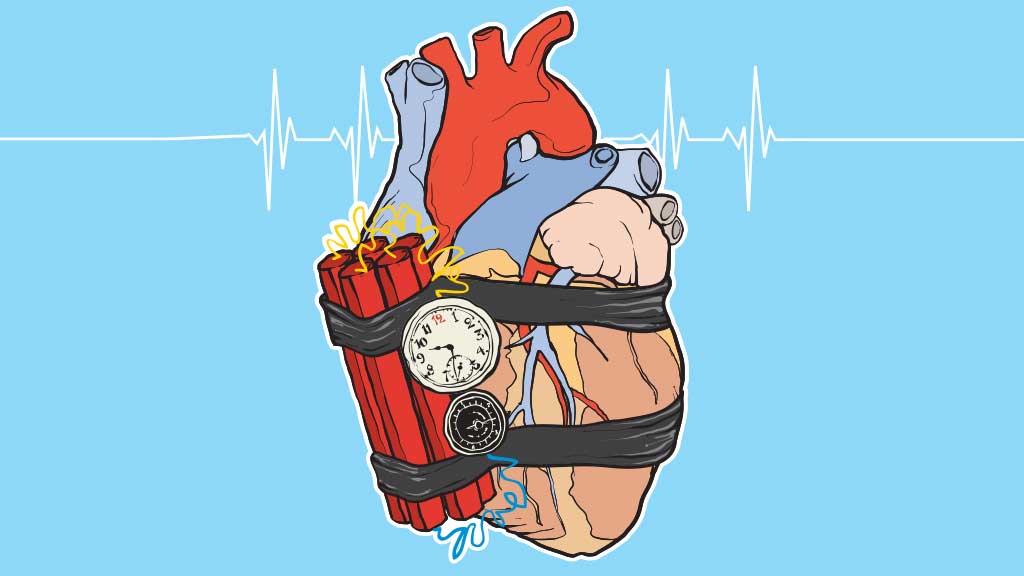A 2017 study found that over 30% of hospitalisations for heart failure in Australia and New Zealand resulted in death or readmission within 30 days (Labrosciano et al. 2017).
Unfortunately, few working solutions for reducing readmission are routinely offered outside of an ever-expanding series of medication options.
Factors Affecting Heart Failure Readmission Rates
Diet and Exercise
Some recommendations stress non-pharmacological management of heart failure (HF) patients. For one, there is a need to educate and counsel patients about the importance of dietary restriction of salt and fluid management (water restriction). Failure to manage both of these dietary elements is a common cause of flare-ups in congestive heart failure patients.
Unfortunately, there is a cataclysmic disconnect between the provision of ‘good counsel’ and proper follow-through. When a patient receives stellar advice from a qualified professional, all that has occurred is a (often one-way) discussion.
It remains wholly possible for the patient to ignore, forget or otherwise dismiss every dietary pearl they receive only to remember them when poised on the gurney’s edge. This is not necessarily willful disregard. Truthfully, often, the patient just has one too many things on their plate to allow for thoughtful dietary management.
The same is true for many other recommendations that can be made to decrease the risk of rehospitalisation. A strong case can be made for HF patients to seek proper exercise instruction, as regular activity has been shown to be of prime importance in the management of their disease.

Therapists can teach exercise, implement practice sessions, correct form and cheerlead. Unfortunately, even a master clinician is unable to make a single person rise up from the recliner once the therapist leaves the building.
Mental Health
A lack of willingness to participate in the joys of exercise may not actually be a lack of willingness to participate - it could, instead, be depression. Depression affects one-fifth of patients with chronic heart failure (Bordoni et al. 2018). Therefore, patients with HF could benefit from screening for depression.
Medication Management
Guidelines make a compelling argument for having a qualified practitioner routinely review and simplify the patient's medication regimen. Determining whether patients have the cognitive capacity to manage complex medication regimens is vital in assessing and altering these regimens to reduce any such complexities.
All of these recommendations - in addition to the useful pharmacological remedies available - can be helpful in the management of heart failure. Unfortunately, none of them addresses the real question: Why do these patients end up back in the hospital so quickly?
This may be a problem of paradigm rather than a failure of innovation. The healthcare system tends to identify 'risk' as the sum total of meticulously collected data points culled from inpatient records and administrative data: age, gender, clinical signs, payer source, comorbidities and so on.
What's Missing From This Equation?
The missing factor seems to be a discussion of the environment. Healthcare providers need to ask themselves: into what level of chaos is this patient being discharged?
Over the last few years, attention has - finally, properly - been shifting onto the role that social instability can play in the revolving door syndrome of hospitalisation. Social instability is a term of convenience used to reflect ‘a relative lack of social support, education, economic stability, access to care, and safety in the patient’s environment’ (Hersh et al. 2013).
Environmental Social Instability
So, how can these factors be quantified? As early as 2008, Arbajie and colleagues made one of the first attempts at clarifying the predictive factor of environmental social instability. Their cohort study examined patient environments to find predictors that could signal a propensity for rehospitalisation.
They asked questions that are second nature to the physiotherapist and occupational therapist:
- Does the patient have a regular medical provider?
- Do they require assistance to get to the doctor?
- Do they live alone?
- Are they married?
- Is their spouse healthy?
- Are there kids anywhere nearby?
- Will the kids - or anyone - help with activities of daily living?
- Are there basic functional needs (like showering or preparing meals) that are not being met?
- Are there stairs inside the house that must be navigated?
(Arbaje et al. 2008)
Their conclusions were compelling. Once they adjusted their results for demographics, health and functional status, they were able to focus on which environmental conditions led to early rehospitalisation.
Patients who lived by themselves, who required help with ADLs and did not receive this assistance, who lacked self-management skills, and who had limited education were all at a higher risk of 30-day readmission. An interesting point of this analysis is the fact that after adjusting for these factors, there was no direct relationship between income and risk in this study (Arbaje et al. 2008).

Not all that ails the heart patient is visible… or physical. Therapists who ignore the non-physical elements of CHF do so to their peril. A diagnosis of CHF - especially severe CHF - significantly reduces participation in instrumental, leisure and social activity. The extent of the restriction of participation, however, surprised even the people who first asked the question. For example, despite being younger, their study subjects had given up (on average) 20% more of their activities since being diagnosed with CHF than a population of post-stroke patients (Foster et al. 2011).
Predicting Readmissions
Is it possible to come up with a predictive score for 30-day readmission or death in patients with heart failure?
A group of Australian researchers wanted to know if it was possible to create an 'at risk' index, which would allow resources to be targeted at higher-risk patients. To achieve this, they developed a score for the likelihood of heart failure leading to death or rebound hospitalisation within the 30-day window.
They looked at all kinds of patient data including the patient’s age, gender, marital status, home situation, remoteness index (where in Australia the person lived), presence or absence of insurance, and whether the patient received any home-based therapy.
When the researchers looked at the 'typical' factors often included in such models, they came up with a poorly discriminative model. In other words, the model they thought would work did not do a good job of predicting readmissions.
However, the researchers found that when they added several atypical factors not often included in models such as this, the predictive value improved dramatically. This model became much more predictive by adding testing of the heart (echocardiography), mental health status (including screening for depression), cognition and individualised socioeconomic status to the screen.
In 2017, another Australian study examined whether heart failure patients with multiple comorbidities would be more likely to be readmitted after discharge. The answer was a resounding yes. Patients with diabetes, metabolic and mood disorders were the most likely to be readmitted, with patients with renal failure also showing an elevated risk (Wiley et al. 2018).
Conclusion
The medical system tends to treat HF as a primarily physical problem with physical solutions. However, patients with CHF also experience many 'nonphysical' problems that fall into five broad domains: symptoms, role loss, effective response, coping and social support.
The interprofessional team can provide two sides of the rehabilitation coin for their patients with heart failure. Their ability to provide physical training, educational services, cognitive retraining, medication education and depression screening make them a valuable asset in the ever-expanding quest to diminish hospital readmissions.
Test Your Knowledge
Question 1 of 3
True or false: There is a link between heart failure and depression.
Topics
References
- Arbaje, AI et al. 2008, ‘Postdischarge Environmental and Socioeconomic Factors and the Likelihood of Early Hospital Readmission Among Community-Dwelling Medicare Beneficiaries’, The Gerontologist, vol. 48, no. 4 https://academic.oup.com/gerontologist/article/48/4/495/618632?login=false
- Amarasingham, R et al. 2010, ‘An Automated Model to Identify Heart Failure Patients at Risk For 30-Day Readmission or Death Using Electronic Medical Record Data’, Medical Care, vol. 48, no. 11, viewed 26 February 2024, https://journals.lww.com/lww-medicalcare/abstract/2010/11000/an_automated_model_to_identify_heart_failure.7.aspx
- Bordoni, B, Marelli, F, Morabito, B & Sacconi, B 2018, ‘Depression and Anxiety in Patients with Chronic Heart Failure’, Future Cardiology, vol. 14, no. 2, viewed 26 February 2024, https://www.futuremedicine.com/doi/full/10.2217/fca-2017-0073
- Foster, ER et al. 2011, ‘Executive Dysfunction and Depressive Symptoms Associated With Reduced Participation of People With Severe Congestive Heart Failure’, American Journal of Occupational Therapy, vol. 65, no. 3, viewed 26 February 2024, https://www.ncbi.nlm.nih.gov/labs/pmc/articles/PMC3155250/
- Hersh, AM, Masoudi, FA & Allen, LA 2013, ‘Postdischarge Environment Following Heart Failure Hospitalization: Expanding the View of Hospital Readmission’, Journal of the American Heart Association, vol. 2, no. 2, viewed 26 February 2024, https://www.ahajournals.org/doi/full/10.1161/JAHA.113.000116
- Huynh, QL et al. 2016, ‘Predictive Score For 30-Day Readmission or Death in Heart Failure’, JAMA Cardiology, vol. 1, no. 3, viewed 26 February 2024, https://jamanetwork.com/journals/jamacardiology/fullarticle/2515766
- Huynh, QL et al. 2016, ‘Mild Cognitive Impairment Predicts Death and Readmission Within 30 Days of Discharge for Heart Failure’, International Journal of Cardiology, vol. 221, viewed 26 February 2024, https://www.sciencedirect.com/science/article/abs/pii/S0167527316314346
- Labrosciano, C et al. 2017, ‘Rates of 30-Day Readmission and Mortality After Heart Failure Hospitalisation in Australia and New Zealand: A Population Study’, Heart, Lung and Circulation, vol. 26, viewed 26 February 2024, https://www.heartlungcirc.org/article/S1443-9506(17)30770-9/fulltext
- Pinkerman, C et al. 2013, Heart Failure in Adults, Institute for Clinical Systems Improvement, viewed 26 February 2024, https://jesse.tg/ngc-archive/summary/9982
- Tully, PJ et al. 2016, ‘Depression Screening After Cardiac Surgery: A Six Month Longitudinal Follow Up for Cardiac Events, Hospital Readmissions, Quality of Life and Mental Health’, International Journal of Cardiology, vol. 206, viewed 26 February 2024, https://www.sciencedirect.com/science/article/abs/pii/S0167527316300274
- Wiley, JF et al. 2017, ‘Multimorbidity and the Risk of All-Cause 30-Day Readmission in the Setting of Multidisciplinary Management of Chronic Heart Failure: A Retrospective Analysis of 830 Hospitalized Patients in Australia’, The Journal of Cardiovascular Nursing, vol. 33, no. 5, viewed 26 February 2024, http://europepmc.org/article/med/28107252
 New
New 
